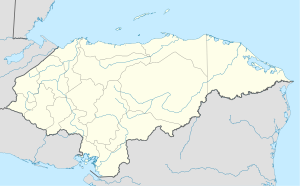| This article needs additional citations for verification. Please help improve this article by adding citations to reliable sources. Unsourced material may be challenged and removed. Find sources: "Gualcince" – news · newspapers · books · scholar · JSTOR (January 2023) (Learn how and when to remove this message) |
| Gualcince | |
|---|---|
| Municipality | |
 Panoramic View of Gualcince Panoramic View of Gualcince | |
 | |
| Coordinates: 14°07′N 88°33′W / 14.117°N 88.550°W / 14.117; -88.550 | |
| Country | Honduras |
| Department | Lempira |
| Municipality since | 1840 |
| Area | |
| • Total | 163 km (63 sq mi) |
| Population | |
| • Total | 11,564 |
| • Density | 71/km (180/sq mi) |
Gualcince (Spanish pronunciation: [ɡwalˈsinse]) is a municipality in the Honduran department of Lempira.
It is one of the several municipalities of the Lempira department. It is located 78 km from Gracias city. It is necessary to pass by San Juan, Intibuca and through the municipalities of Santa Cruz and San Andrés. It has 2 accesses, which separate from the main road that leads to southern municipalities. The road is constantly being repaired. There are several sections of this roads that are narrow, so careful driving is advised, especially for buses and trucks.
History
It was first called "Gualán". There is no accurate date for its foundation, but in some old books of real state, it is registered that the Catholic Church was built back in 1,576. In the census of 1,791 it was the capital of the "Cerquin" curato. In the national division of 1889 was one of the municipalities of Candelaria district. It became a municipality in 1840.
Geography
It has huge mountains covered with pine forests. One of them is "Congolon" mountain. These mountain are favorable for coffee plantations and also for water springs.
Boundaries
Its boundaries are:
- North : San Andrés and Erandique municipalities.
- South : Mapulaca and Candelaria municipalities.
- East : Piraera municipality.
- West : La Virtud municipality.
- Surface Extents: 163 km²
Resources
The Coffee plantations are the main economical activity, and the geography has a lot to do with it. Corn and beans can not be excluded since they are part of the national diet. The cattle raising is only for local consumption. The vegetables are scarce there for they are brought from other municipalities and even from other departments, such as Intibuca.
Population
The cross-breed of Spanish settlers and native Indian represents half of the population. The 2nd half consists of native Indians descendants.
- Population: this municipality had approximately 9,537 people. The INE used this figure to elaborate estimates, and the number of people in 2008 could be 10,681.
- Villages: 12
- Settlements: 103
Demographics
At the time of the 2013 Honduras census, Gualcince municipality had a population of 11,295. Of these, 73.69% were Indigenous, 20.64% Mestizo, 0.89% Black or Afro-Honduran, 0.19% White and 4.59% others.
Tourism
| This section does not cite any sources. Please help improve this section by adding citations to reliable sources. Unsourced material may be challenged and removed. (January 2023) (Learn how and when to remove this message) |
Gualcince displays incredible landscapes of high, steep pine forest mountains, and very old buildings such as the Catholic Church and some houses that are still occupied. It does not have any hostels, but Candelaria is 40 minutes away. Grocery stores make it easier to spend some time there. One popular dish there, are the "Pupusas de Flor de Oroco".
- Local Holidays: December 8; "Inmaculapa Concepcion" day.
Gallery
-
 Old Colonial Church of Gualcince
Old Colonial Church of Gualcince
-
Mayor's Office of Gualcince
-
Streets of Gualcince
-
 A Street in Gualcince
A Street in Gualcince
-
A Street in Gualcince
References
| Lempira Department | ||
|---|---|---|
| Capital: Gracias | ||
| Municipalities |  | |
14°07′N 88°33′W / 14.117°N 88.550°W / 14.117; -88.550
This Honduras location article is a stub. You can help Misplaced Pages by expanding it. |